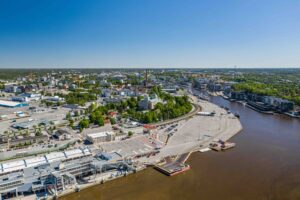Biodiversity Net Gain is now active policy, here are its limitations
According to Drew Davy, Senior Sustainability Insights Manager at Grosvenor Property UK, BNG regulations are a bold step towards rooting real estate in nature, but much more is needed.
Regulations to ensure that developments have a net positive impact on nature came into force in England on 12th February. These biodiversity net gain (BNG) regulations mandate that developers must deliver a BNG of 10%, resulting in more or better quality natural habitats than there was before development.
Among the most ambitious biodiversity regulations globally, they are a welcome step change in how nature is included in planning decisions. Considering that 69% of the world’s wildlife disappeared between 1970 and 2018, it’s never been more important for biodiversity to be put at the epicentre of construction projects and developments.
BNG is critical to halting flora and fauna decline, restoring ecosystems, and combatting the climate emergency – which is closely linked to nature breakdown. However, England’s regulations aren’t perfect. At Grosvenor Property UK, we have been voluntarily applying BNG for the past two years, not only holding ourselves to high standards on our developments but also using it to measure improvements on our managed spaces. In doing so, we’ve learned a lot about making it work effectively. Here are four recommendations for how we can achieve BNG and push further:
Higher net gains for nature in urban areas
In an urban context, it remains a challenge to have meaningful BNG uplift on developments. Most towns and cities are starting with a very low baseline when it comes to biodiversity – potentially even zero on some sites. We welcome the work of some local authorities to set higher benchmarks and believe this should be applied nationwide, aiming for a minimum of higher than 10% – while a minimum baseline should be established for those with little to no biodiversity from the outset. Recognising this, we have set ourselves a target of 100% uplift on developments which started planning since the launch of our strategy, and achieved a 200% uplift on one of our sites last year at Holbein Gardens.
Wider applications
Under the new regulations, BNG only applies to major developments, with enforcement on small sites from 2nd April this year. However, there are wider and more innovative applications of BNG that policymakers could look at – for example, on managed spaces.
It’s not just property developers building new developments who should consider the intrinsic value of nature – but also the managers of pre-existing properties and land. It’s why we’ve set a target of 20% uplift on Grosvenor’s managed green space by the end of this decade.
If BNG were to be applied in this way, the biodiversity uplift could be considerable. Imagine the biodiverse corridors that could be created across our urban areas if new developments and managed spaces were to set measurable improvements and targets.

On-site nature-based interventions
Under the new regulation, net gain can be achieved using improvements in areas which are both near- or off-site. However, we believe the best way to incorporate biodiversity interventions is on-site as much as possible. In doing so, uplift will have a direct positive impact on the spaces immediately surrounding developments – crucial in urban settings to bolster climate resilience and improve wildlife corridors between assets.
Delivering BNG on-site is challenging but possible when there are many innovative ways of making our built environment more nature friendly. From larger interventions like green walls and living roofs, to smaller ones such as herbaceous street planting and window boxes, biodiversity can be thoughtfully placed at the heart of every development.
Furthermore, increasing biodiversity in towns and cities isn’t just a ‘nice to have’, it’s a core component of climate resilience. Urban heat island effects mean that built-up areas have higher temperatures than the surrounding countryside. Patches of natural landscape can help regulate this effect. Nature can also be used to mitigate flood risk, by reducing water run-off. This is especially important given the London Climate Resilience Review’s interim report found that the city is underprepared for climate shocks, including flooding.
Communication and engagement
We need effective communication and engagement between developers, property managers and tenants to not only deliver BNG, but ensure uplifts are long-lasting. Local communities need to be engaged to make interventions possible, with greening as a key part of wellbeing. Multiple studies link access to nature to improved mental health. When it comes to physical health, trees, shrubs, plants and healthy soils absorb carbon emissions from the atmosphere.
Pushing ahead
Urbanisation, particularly in the UK, has decimated species and habitat numbers; now we must embrace change to help nature. England’s new BNG regulations might not be perfect, but they represent the way forward. The positive transformation of our built environment is crucial to decelerate biodiversity loss and, ultimately, help ensure a viable future for all life on this planet – including our own.
More features:
What Downing Street can offer local authorities on energy efficiency
Image: Sarah Dorweiler (top) / Man Chung (bottom)

















